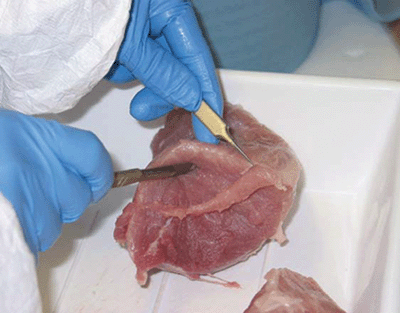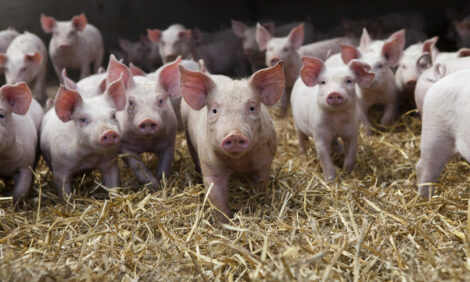



Testing the Safety of Genetically Modified (GM) Feed Ingredients in Pigs
Research at Teagasc in the Republic of Ireland reveals that feeding GM maize to pigs of different ages and for extended periods of time is as safe as its conventional counterpart with respect to potential effects on animal health. Results revealed no reason for concern regarding the safety of the GM peas tested.
Principal Research Officer,
Dr Maria Walsh,
Research Officer,
Stefan Buzoianu,
Teagasc Walsh Fellow, Pig Development Department, Animal and Grassland Research and Innovation Centre, Teagasc, Moorepark
Dr Mary Rea,
Senior Research Officer,
Professor Paul Ross,
Head of Food research Programme, Teagasc Food Research Centre, Moorepark
Dr Gillian Gardiner,
Lecturer, Department of Chemical and Life Sciences, Waterford Institute of Technology
A three-and-a-half year research project was conducted by staff of Teagasc's Pig Development Department to determine health effects in pigs fed genetically modified (GM) maize and peas. The results of this project are important, as EU consumer confidence in GM technology is low, largely due to perceived health risks associated with the consumption of GM food.
The GMSAFOOD Project
Teagasc was a partner in the EU GMSAFOOD project whose principle objective was to determine the safety of GM food/feed ingredients. The consortium focused its work on Bt maize (MON810) and α-amylase inhibitor (αAI) peas, both of which were bred for their insect-resistant properties and grown in Spain. The work conducted by the consortium included:
- The production of αAI peas (CSIRO, Australia)
- Long-, medium- and short-term pig feeding studies (Teagasc, Ireland)
- Salmon feeding studies (NVH, Norway)
- Human immune response to potential allergens in GM peas using human-SCID mice (MUW, Austria)
- Food chain studies in which rats were fed pork and fish that had been raised on Bt maize (NVH, Norway)
- Epitope mapping and antibody determinations (CFRI, Hungary)
Pig Feeding Studies
Bt (MON810) maize
Weaned pigs were fed diets containing non-GM or
GM (Bt MON810) maize for 31 or 110 days. A trans-generational experiment was also conducted, whereby
pregnant sows were fed non-GM or GM maize diets with the progeny of both groups being fed non-GM or
GM maize diets to commercial slaughter weight.
These experiments investigated the effects of GM maize on
growth performance, intestinal histology, immune response, intestinal microbiology and organ weight and function. Analysis was also performed to determine if the gene encoding the protein responsible for the genetic modification of the maize, or the protein itself, moved out of the animal's digestive tract.
The main results from this work include:
- Feed intake, growth rate and feed conversion efficiency of pigs were not adversely affected when pigs were fed GM maize.
- As an indicator of toxicity, the effect of GM maize consumption on the structure and function of the liver, heart, kidneys and spleen of the pigs was determined. Organ pathology and organ function were similar for pigs fed GM or non-GM maize.
- There was no adverse effect of feeding GM maize on small intestinal morphology.
- Comparison of the immune response of pigs fed GM maize or non-GM maize failed to reveal differences of biological importance. Antibodies specific to the GM maize protein (Cry1Ab) were not detected in the pigs’ blood, indicating the absence of an allergic-type immune response to the protein.
- In addition to conventional culturing techniques, gene sequencing was used to determine if feeding GM maize influenced the bacterial profile within the digestive tract. Counts of selected culturable bacteria were unaffected by feeding GM maize. High-throughput gene sequencing revealed that GM maize consumption had only minimal impact on microbial community structure in the caeca of pigs, resulting in statistically significant differences in abundance of only two of 39 bacterial families and three of 54 genera detected. Furthermore, the taxa affected were detected at low abundance and frequency and their role within the intestine is not fully understood. Therefore, the differences observed are not believed to be of major biological importance and in addition, were not associated with any adverse health effects.
- Neither the cry1Ab gene nor the Cry1Ab protein were found in the blood, organs or muscle of pigs fed the GM maize. These findings indicate that the gene or protein did not migrate from the digestive system of the animal into other body tissues. Our results also indicate that the cry1Ab gene was broken down as it moved through the digestive system, being found in the stomach contents but not in the colon. As anticipated, fragments of the Cry1Ab protein were found throughout the gastrointestinal tract.

α-Amylase inhibitor peas
In a 31-day experiment weaned pigs were fed diets containing:
- non-GM commercial field peas (Pisum sativum L.)
- non-GM parent line peas (Pisum sativum L.)
- GM peas (Pisum sativum L.) expressing αAI-1 from the common bean (Phaseolus vulgaris)
This experiment investigated the effects of the αAI peas on pig growth, blood haematology, organ weight and function.
Feed intake, growth rate and feed conversion efficiency of pigs were similar regardless of treatment.
Likewise, there was no difference in the weight of the heart, kidneys, liver or spleen between treatments and evidence of pathology was absent from the organs of pigs fed all of the pea treatments.
Differences were observed in haemogloblin concentration and haematocrit between treatments; however, the differences were only found between pigs fed the non-GM parent pea diet and pigs fed the other two pea treatments with no difference between the non-GM commercial field pea and the GM pea being found.
Differences in mean platelet volume were also found between treatments; however, the GM pea was not different to the non-GM parent counterpart but was different from the non-GM commercial field pea.
These results highlight the importance of correctly interpreting data on GM ingredients. Even a comparison between two conventional varieties of any feed ingredient is likely to yield differences in some parameters of interest. Therefore, it is important that feeding trials investigating the safety of GM ingredients should also include a comparison to conventional varieties of the same feed ingredient.
Conclusions and Implications
Based on the results, the authors concluded that the GM maize did not have harmful effects on growth, intestinal health or organ function of pigs. Bacteria within the digestive systems of pigs are tolerant of the GM maize.
In addition, the cry1Ab gene as well as the protein itself have been shown not to migrate from the digestive tract and the gene was broken down as it progressed through the digestive tract.
It was concluded that feeding GM maize to pigs of different ages and for extended periods of time is as safe as its conventional counterpart with respect to potential effects on animal health.
Furthermore, the results did not reveal any reason for concern regarding the safety of the αAI peas tested. The latter experiment highlights the need to include multiple conventional comparators of the same feed ingredient during safety assessment.
Acknowledgements
The research leading to these results received funding from the European Union's Seventh Framework Programme (FP7/2007-2013) under grant agreement number 211820 and Teagasc's Walsh Fellowship programme.
April 2013








